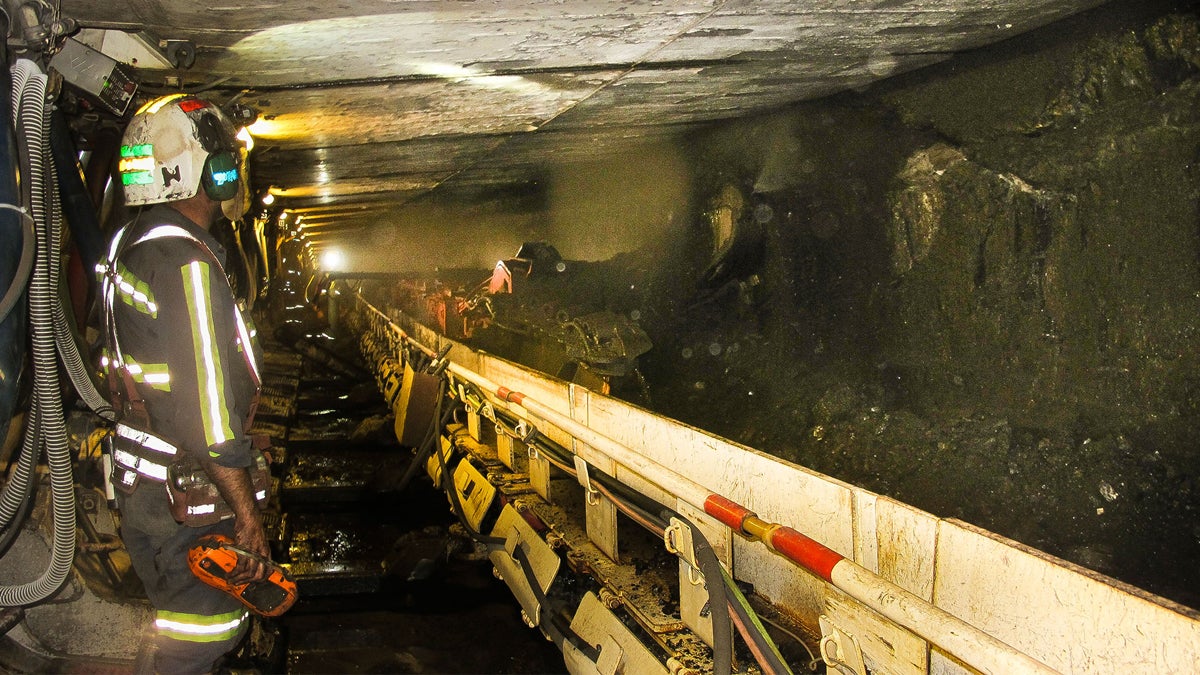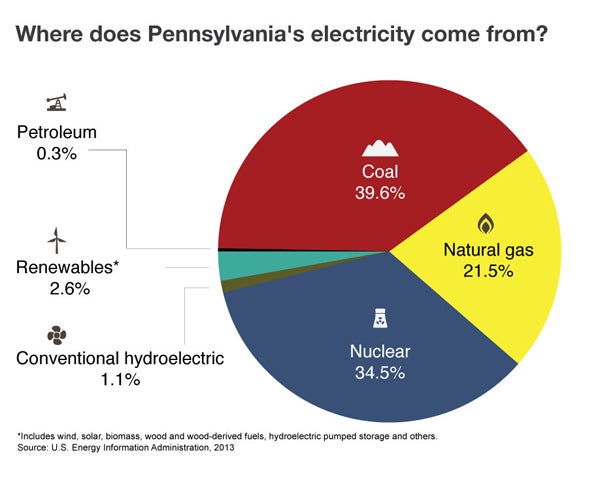Pennsylvania’s coal industry faces uncertain future
Listen
The Alpha Natural Resources Cumberland mine in Greene County. Coal currently supplies 40 percent of Pennsylvania’s electricity, but industry advocates say coal faces a “perfect storm” of problems right now — from tougher carbon regulations, to low electric demand, and competition from natural gas. (Marie Cusick/StateImpact)
Looking out the car window on the Pennsylvania Turnpike, you can see a massive pile of waste coal near mile marker 117 in Somerset County. It’s refuse from an active deep mine nearby. It’s also an example of how important coal mining is to many communities across the state. Although the coal industry has gotten cleaner, it’s still dirty. Coal-fired power plants are the largest contributors of the nation’s greenhouse gases.
[Part one of five]
Pennsylvania is third in the nation for energy production. It’s also in third place for carbon dioxide emissions. As the federal government pushes states to cut emissions that are leading to climate change, StateImpact Pennsylvania profiled five major energy sources: coal, wind, nuclear, solar and oil.
Alpha Natural Resources Cumberland Mine
Looking out the car window on the Pennsylvania Turnpike, you can see a massive pile of waste coal near mile marker 117 in Somerset County. It’s refuse from an active deep mine nearby. It’s also an example of how important coal mining is to many communities across the state. Although the coal industry has gotten cleaner, it’s still dirty. Coal-fired power plants are the largest contributors of the nation’s greenhouse gases.
The industry that powered an industrial revolution remains haunted by its messy legacy — piles of waste coal, streams running orange with acid mine drainage, and air filled with pollution.
But even now, well into the 21st century, Pennsylvanians rely heavily on coal. It supplies 40 percent of the state’s electricity.
‘We need coal’
I’m 1,000 feet underground; it’s dark and noisy at Alpha Natural Resources Cumberland mine. It’s in Greene County, close to the West Virginia border. Dan Rose is the longwall superintendent. He points to the face of the mine where workers are monitoring equipment that shaves off massive chunks of coal from the Pittsburgh seam.
“This is the main seam of coal here,” he says.
I ask him how he describes his job to people unfamiliar with the industry.
“I just tell them, give it a few years and see what your electric bill does,” he laughs. “Go a little bit of time without coal and see what your electric bill does.”
Coal is also embedded in the culture of Southwestern Pennsylvania.
Randy Patton has spent much of the past 30 years underground. He describes it like working in a basement with no windows.
“It’s a tough life. I’ve been here since I basically got out of high school and it’s catching up,” he says. “But it’s a good living. We need coal.”
But environmental advocates, like Christina Simeone, who heads PennFuture’s Energy Center, say it’s time for a change. She describes our reliance on coal like a stock portfolio.
“Maybe your financial adviser would tell you, maybe if 50 percent of your money is in one investment you might not be diversified enough.”
The world’s scientists have been issuing dire warnings for years, urging people to shift away from fossil fuels, or face the consequences of abrupt climate change. Governor Corbett doesn’t believe the science around the issue is settled yet. Earlier this month, he and 14 other Republican governors from around the country sent a letter to the President, questioning the legality of the federal Environmental Protection Agency’s proposed rules to limit emissions from existing power plants.
At a rally in Pittsburgh over the summer, Corbett called the federal rules a “war on coal.”
“ We’re talking about the production of coal, but it’s much more than that,” he told the crowd. “What is it? It’s jobs. It’s electricity. It’s power.”
‘The dirtiest resource’
Under newly proposed EPA rules, Pennsylvania will have to cut its carbon emissions by about 32 percent over the next 15 years. But the commonwealth gets to choose how to meet that target—through pushing more efficiency, or cleaner forms of energy. The EPA plans to finalize the rules by next year.
Simeone says it won’t mean the end of coal, just less of it.
“It’s no secret that coal is the dirtiest resource that we utilize,” she says. “So it becomes a less competitive resource because of what science tells us. We value dirty resources less than we value cleaner resources.”
But beyond the fight over climate change, the coal industry is facing other market-driven challenges.
For one thing, demand for electricity never recovered from pre-Recession levels. The other big issue is competition from natural gas. The boom in Marcellus Shale drilling is leading to a shift away from coal to cleaner-burning gas in electric power generation.
The changes facing the coal industry are well understood at Alpha Natural Resource’s Cumberland mine
It opened up in 1974 and employs 650 people, and all of them know it will close someday. Mine superintendent Jeff Everett has been here since he was 19, and now has son who works underground.
“When you know you have a limited resource, and you know you’re extracting coal, you also know you’re working towards and end.”
The end is coming soon for Alpha’s nearby Emerald Mine, which employs 500 workers.
Citing its reserves and poor market conditions, the company plans to close it sometime next year.

Credit: Rachel Feierman for NewsWorks/WHYY
WHYY is your source for fact-based, in-depth journalism and information. As a nonprofit organization, we rely on financial support from readers like you. Please give today.




